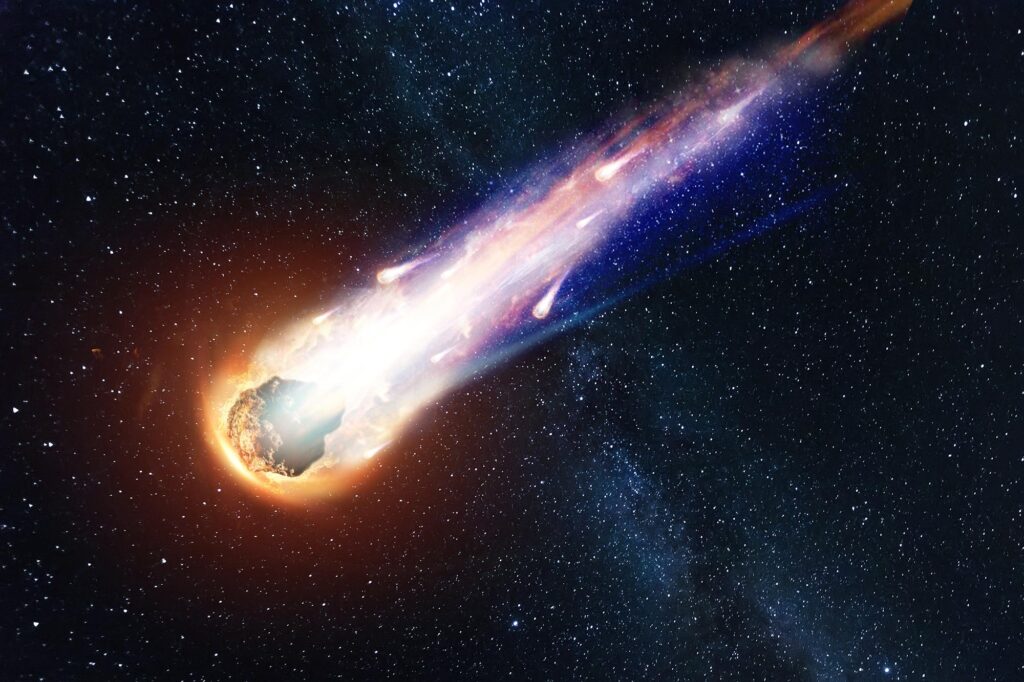Faberge eggs are some of the most luxurious and coveted items in the world. These intricately designed and crafted eggs were created by the House of Faberge in Russia during the late 19th and early 20th centuries. Each egg is a unique work of art, made with precious materials and adorned with intricate details. Among the many Faberge eggs that have been created, there are 10 that stand out as the most expensive. These eggs are not only beautiful but also have a rich history and significance that makes them truly priceless. In this article, we will take a closer look at the 10 most expensive Faberge eggs and explore the stories behind them.
| No | Most Expensive Faberge Egg | Price |
| 1 | The Third Imperial Easter Egg | $33 million |
| 2 | The Rothschild Egg | $25.1 million |
| 3 | The Imperial Coronation Egg | $18 million |
| 4 | Winter Egg | $15.6 million |
| 5 | The Bay Tree Egg |
$15 million
|
| 6 | The Fifteenth Anniversary Egg |
$15 million
|
| 7 | The Lilies of the Valley egg | $13 million |
| 8 | Cradle with Garlands Egg | $6.65 million |
| 9 | The Rosebud Egg | $4 million |
| 10 | The Hen with Sapphire Pendant | $308,389 |
The Third Imperial Easter Egg
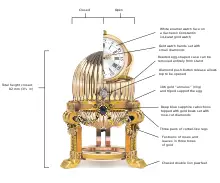
The Third Imperial Easter Egg is the most expensive Faberge Egg in the World. The Third Imperial Easter Egg, also known as the “Imperial Egg with the surprise of the golden cockerel,” was created by Peter Carl Fabergé for Tsar Nicholas II of Russia in 1908. The egg is made of gold, covered in white enamel, and decorated with diamonds, rubies, and sapphires. The egg opens to reveal a golden cockerel with ruby eyes and a diamond-studded tail. The cockerel is also made of gold and is mounted on a small pedestal made of gold and enamel. The egg was given to the Tsar’s mother, the Dowager Empress Maria Fyodorovna, as a gift for Easter in 1908. It is currently on display at the Moscow Kremlin Armoury Museum in Russia.
The Rothschild Egg
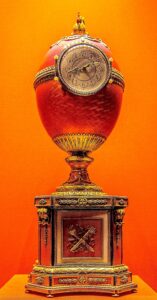
The Rothschild Egg is the 2nd most expensive Faberge Egg in the World. The Rothschild Egg is a famous and highly valuable Fabergé egg created for the Rothschild family in 1902. The egg is made of gold and enamel and is decorated with diamonds, rubies, and sapphires. It opens to reveal a golden yolk that contains a replica of the Imperial Crown of Russia, complete with a miniature portrait of Tsar Nicholas II. The egg was purchased by the Rothschild family in 1907 and remained in their possession until it was sold at auction in 2007 for over $18 million. It is considered one of the most impressive and valuable Fabergé eggs in existence.
The Imperial Coronation Egg
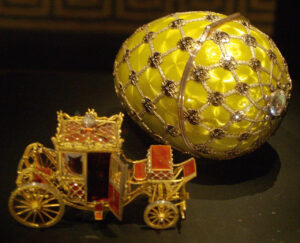
The Imperial Coronation Egg is the 3rd most expensive Faberge Egg in the World. The Imperial Coronation Egg is a Fabergé egg created in 1883 for Tsar Alexander III of Russia as a gift for his wife, Tsarina Maria Feodorovna. The egg is made of gold and is adorned with diamonds, rubies, and sapphires. The egg opens to reveal a miniature replica of the coronation carriage of Tsar Alexander III and Tsarina Maria Feodorovna. The egg is considered one of the most important and valuable Fabergé eggs in existence and is currently on display at the Kremlin Armoury Museum in Moscow, Russia.
Winter Egg
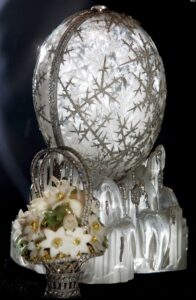
Winter Egg is the 4th most expensive Faberge Egg in the World. A winter egg is a type of egg that is produced during the winter months by certain types of birds, such as chickens, ducks, and geese. These eggs are typically larger and more nutritious than eggs produced during other seasons, as birds use more energy to survive in the colder weather. They may also have a thicker, more durable shell due to the colder temperatures. Winter eggs are often used in cooking and baking, as well as for making holiday treats and decorations.
The Bay Tree Egg
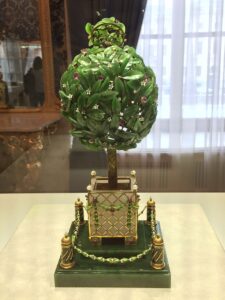
The Bay Tree Egg is the 5th most expensive Faberge Egg in the World. The Bay Tree Egg is a type of preserved egg that is made by marinating eggs in a mixture of bay leaves, soy sauce, and other seasonings. The eggs are then left to cure for several weeks, resulting in a rich, savory flavor and a dark brown color. The Bay Tree Egg is a popular ingredient in many Asian dishes, such as congee, fried rice, and stir-fries. It is also commonly served as a side dish or snack.
The Fifteenth Anniversary Egg
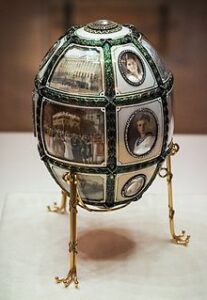
The Fifteenth Anniversary Egg is the 6th most expensive Faberge Egg in the World. The Fifteenth Anniversary Egg is a special commemorative egg traditionally given as a gift to celebrate 15 years of marriage. It is often made of precious materials such as gold or silver and may be decorated with intricate designs or engravings. Some couples choose to have their names and wedding date engraved on the egg as a lasting reminder of their special day. The egg may also be filled with small trinkets or keepsakes that hold sentimental value to the couple. It is a symbol of the strength and longevity of their marriage and a reminder of their love and commitment.
The Lilies of the Valley egg
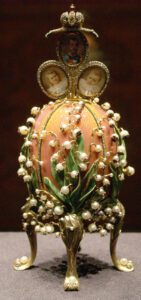
The Lilies of the Valley egg is the 7th most expensive Faberge Egg in the World. The Lilies of the Valley egg is a Fabergé egg created in 1898 for Tsar Nicholas II of Russia. It was the third of the Imperial Fabergé eggs given as a gift to Tsarina Alexandra Feodorovna. The egg is made of white enamel and is decorated with a gold and diamond trellis, with lilies of the valley flowers made of pearls and diamonds. The egg also has a surprise inside, which was a miniature bouquet of lilies of the valley made of gold and diamonds. The egg is now part of the collection at the Fabergé Museum in St. Petersburg, Russia.
Cradle with Garlands Egg
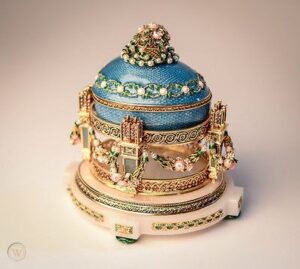
Cradle with Garlands Egg is the 8th most expensive Faberge Egg in the World. The Cradle with Garlands Egg is a decorative Easter egg that features a small cradle decorated with garlands of flowers and leaves. It is typically made of porcelain or other decorative materials and is often used as a decorative piece in Easter displays or as a gift for loved ones. The egg may also be painted with intricate designs and patterns, making it a beautiful and unique piece.
The Rosebud Egg
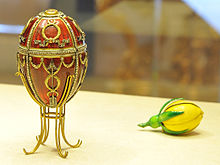
The Rosebud Egg is the 9th most expensive Faberge Egg in the World. The Rosebud Egg is a Fabergé egg created in 1895 for Tsar Nicholas II of Russia. It was made by the House of Fabergé, a famous Russian jewelry company known for creating intricate and elegant eggs as gifts for the royal family. The Rosebud Egg is made of gold and is adorned with diamonds, rubies, and a rosebud made of enamel. The egg opens to reveal a gold and enamel flower basket, which contains a small golden rosebud. The egg was given to Tsarina Alexandra as an Easter gift and is now part of the collection of the Kremlin Armory Museum in Moscow.
The Hen with Sapphire Pendant
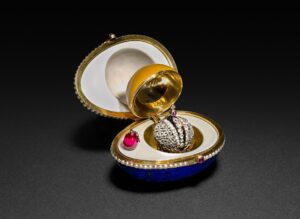
The Hen with Sapphire Pendant is the 10th most expensive Faberge Egg in the World. The Hen with Sapphire Pendant Fabergé egg is a beautiful and intricate piece of art created by the famous Fabergé workshop in Russia. The egg is made of gold and is adorned with a sapphire pendant in the shape of a hen. The egg opens to reveal a surprise inside, typically a miniature object or scene. This particular egg was created in the early 20th century and is considered a rare and valuable piece of art. It is part of the famous Imperial Easter eggs series commissioned by the Russian royal family. The Hen with Sapphire Pendant Fabergé egg is currently displayed in a museum or private collection.
Frequently Asked Questions
What is a Faberge egg?
A Faberge egg is a decorative egg that is made of precious metals and stones and is often intricately adorned with intricate designs and intricate details. The eggs were created by the House of Faberge, a Russian jewelry firm that was founded in 1842 by Peter Carl Faberge. The eggs were originally commissioned by the Russian royal family as Easter gifts and were considered to be some of the most valuable and collectible pieces of art in the world. Today, Faberge eggs are highly sought after by collectors and are considered to be some of the most valuable pieces of art in the world.
How much is a Faberge egg worth?
The value of a Faberge egg can vary greatly depending on its rarity, condition, and provenance. Some of the most valuable Faberge eggs have sold for millions of dollars at auction. For example, the Rothschild Faberge egg, which was made in 1902 and sold at auction in 2007, sold for $18.5 million. The Winter Egg, which was made in 1913 and sold at auction in 2002, sold for $9.6 million. However, it’s also possible to find Faberge eggs for sale at a much lower price. It’s important to note that there are also many counterfeit Faberge eggs on the market, so it’s important to purchase from a reputable source.
How to tell a real Faberge egg?
- Look for the hallmark: The most reliable way to tell a real Faberge egg is by looking for the hallmark. The hallmark is a small stamp or inscription on the egg that indicates it was made by Faberge.
- Examine the craftsmanship: Faberge eggs are known for their intricate and detailed craftsmanship. Look for details such as miniature paintings, enamel work, and intricate engravings.
- Check for authenticity certificates: Many Faberge eggs come with authenticity certificates from reputable organizations or experts in the field. These certificates can confirm the egg’s authenticity.
- Compare to known examples: If you are unsure about the authenticity of a Faberge egg, compare it to known examples of real Faberge eggs. This can help you identify any discrepancies or differences.
- Consult an expert: If you are still unsure about the authenticity of a Faberge egg, consult an expert in the field. They can examine the egg and provide a more accurate assessment of its authenticity.
What are the 7 missing Fabergé eggs?
- The Third Imperial Easter Egg (1909)
- The Alexander III Commemorative Egg (1894)
- The Empire Nephrite Egg (1902)
- The Rosebud Egg (1899)
- The Lilies of the Valley Egg (1898)
- The Coronation Egg (1897)
- The Blue Serpent Clock Egg (1897)
What is the most famous Fabergé egg?
The most famous Fabergé egg is the Imperial Easter Egg, also known as the Tsar Imperial Easter Egg or the Fabergé Easter Egg, which was created for Tsar Alexander III and his wife, Tsarina Maria Feodorovna, in 1887. The egg is made of gold is adorned with precious jewels and features a miniature replica of the royal crown inside.
Who owns most Fabergé eggs?
The Royal Collection Trust, which manages the British Royal Collection, owns the largest collection of Fabergé eggs, with a total of nine eggs. The Russian Kremlin Armoury Museum also has a significant collection of Fabergé eggs, with a total of 43 eggs.
How many Fabergé eggs are left?
Approximately 50 Fabergé eggs are known to exist today.
Does Queen Elizabeth own any Fabergé eggs?
Yes, Queen Elizabeth II owns several Fabergé eggs in her collection. Some of the most notable ones include the Imperial Coronation Egg, the Imperial Easter Egg, and the Imperial Fabergé Egg.
How many Fabergé eggs does the queen own?
The Queen of England, Queen Elizabeth II, owns four Fabergé eggs.
When was the last Fabergé egg sold?
The last Fabergé egg known to be sold was the “Winter Egg” which was sold at a Christie’s auction in London on April 9, 2007, for a record-breaking $9.6 million.
What is the rarest egg in the world?
The rarest egg in the world is the “nest egg” of the extinct elephant bird (Aepyornis Maximus) of Madagascar. These eggs can weigh up to 10 pounds and are roughly the size of a watermelon. Due to hunting and habitat destruction, the elephant bird went extinct in the 17th century, making their eggs extremely rare and valuable.
What is the least expensive Faberge egg?
The least expensive Faberge egg is the “Hen Egg” which was created in 1885 and sold for $14.16 million at an auction in 2007.
Are Fabergé eggs fragile?
Yes, Fabergé eggs are quite fragile as they are made from precious materials such as gold, enamel, and precious stones. They are also intricate works of art with many delicate details and moving parts. Any damage or mishandling can easily cause irreparable damage to the egg.
Are there any Fabergé eggs in the US?
Yes, there are several Fabergé eggs in the US. The largest collection of Fabergé eggs in the US is at the Hillwood Estate, Museum & Gardens in Washington, D.C., which has nine eggs in its collection. Other notable collections of Fabergé eggs in the US include the Virginia Museum of Fine Arts in Richmond, Virginia, which has four eggs in its collection, and the Metropolitan Museum of Art in New York City, which has three eggs in its collection. Additionally, there are several private collections of Fabergé eggs in the US.
Why are Fabergé eggs so special?
Fabergé eggs are special for several reasons:
- They are incredibly intricate and detailed: Each Fabergé egg is a work of art, crafted by skilled artisans using various precious materials such as gold, silver, and precious gems. The eggs feature intricate designs and intricate mechanisms that reveal hidden surprises inside.
- They are incredibly rare: Fabergé eggs were only made between 1885 and 1917, and only a limited number were created. Today, only about 50 of the original eggs are known to still exist.
- They have a rich history: Fabergé eggs were created for the Russian Imperial family, and many of them were given as gifts to the Tsar and his family. They have been passed down through generations, and have become symbols of the opulence and grandeur of the Russian Imperial court.
- They are incredibly valuable: Due to their rarity and intricate craftsmanship, Fabergé eggs are considered some of the world’s most valuable works of art. Some of them have sold for millions of dollars at auction.
- They are a symbol of Russian Art: Fabergé eggs are one of the most iconic and enduring symbols of Russian art and craftsmanship. They are considered to be masterpieces of the Art Nouveau style, and they continue to inspire artists and art lovers around the world.
How many Russian Fabergé eggs are missing?
It is estimated that around 50 Russian Fabergé eggs are missing. Some were lost or destroyed during the Russian Revolution, while others have gone missing due to theft or other circumstances.
Who owns the original Fabergé eggs?
The original Fabergé eggs are owned by various private collectors and museums around the world. Some notable examples include:
- The Royal Collection of the British Royal Family, which owns nine Fabergé eggs
- The Virginia Museum of Fine Arts, which owns the Fabergé egg “The Pelican”
- The Forbes Collection, which owns the Fabergé egg “The Coronation”
- The Kremlin Armoury Museum in Moscow, which owns the Fabergé egg “The Imperial Easter Egg”
- The Hillwood Estate, Museum & Gardens in Washington D.C., which owns the Fabergé egg “The Lilies of the Valley”
It’s worth noting that many of the original Fabergé eggs were sold or confiscated during the Russian Revolution and their current ownership history is not always clear.




